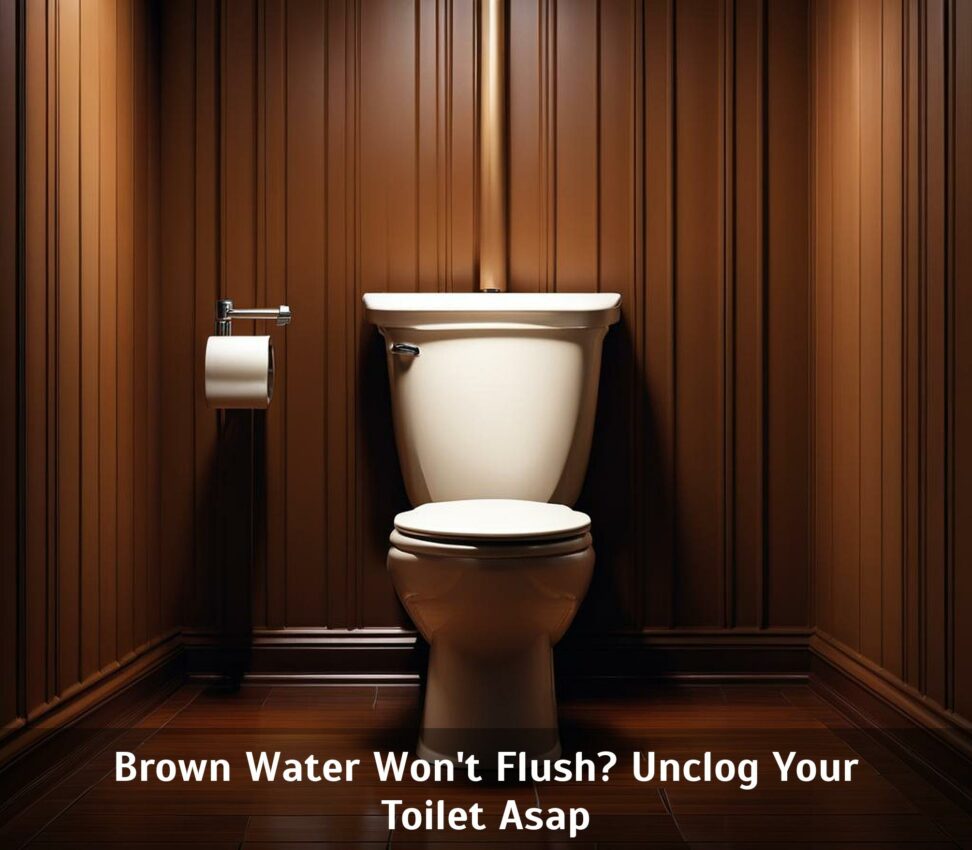Brown Water Won't Flush? Unclog Your Toilet Asap
Opening the lid to a toilet bowl full of brown water can certainly be an alarming sight. That morning bathroom trip suddenly takes a turn as you ponder what could be causing this unpleasant discolored water.
While unnerving, brown water in the toilet is usually easily fixable with some basic DIY troubleshooting. In many cases, it simply indicates a minor clog that needs clearing. Taking quick action to unclog the drain can get your toilet flushing normally again.
Common Causes of Brown Water in Toilet Bowls
Before taking action, it helps to understand what typically leads to brown water filling up the bowl. Here are some of the most common culprits:
- Accumulated waste and clogged drain lines - When drainage pipes get blocked, water can't flush properly. Waste builds up and causes a brown tint.
- Rust buildup in pipes or internal toilet parts - Corrosion can release rust into the water, turning it brown.
- High sediment levels in home water supply - Sediment from pipes or the municipal water source discolors the water.
If the brown water only appears in the toilet and not other faucets, a toilet-specific issue is likely. Rusty parts or a clogged drain line tend to cause isolated toilet problems.

Signs of a Clog Causing Brown Water
How can you confirm it's a clogged drain causing the brown water in your toilet?
Check for these signs of a blockage:
- Weak flush unable to fully clear the bowl
- Gurgling sounds coming from blocked pipes
- Pooling water and potential overflow
A healthy, unclogged toilet will flush with force, evacuating the bowl fully. With a clog, the flush doesn't have enough power to push the waste through.
Using a Plunger to Clear Clogs
Before calling a plumber or taking more drastic measures, try plunging the toilet. A forceful plunge can often dislodge minor clogs.
Follow these steps for effective plunging:
- Choose the correct type of plunger - the flanged style works best for toilets.
- Get a tight seal over the drain hole at the bottom of the bowl.
- Plunge vigorously 15-20 times, angling the force downward to push through the clog.
Take your time and repeat as needed until water starts draining freely. Flushing once or twice while plunging can help clear the blockage.
Drain Cleaners to Break Up Blockages
Liquid drain cleaners offer another DIY solution for stubborn clogs in your toilet.
Using drain cleaner:
- Homemade cleaners with baking soda or vinegar work well for light clogs.
- Commercial enzyme or chemical cleaners help dissolve thicker blockages.
- Carefully pour the cleaner into the bowl and let it work for 10-15 minutes before flushing.
The key is allowing enough time for the active ingredients to penetrate and break down the clogging debris or waste.
Removing Toilet to Thoroughly Clean Pipes
For more impacted clogs that persist after plunging and drain cleaner, removing the toilet may be required.
This involves:
- Shutting off the water supply valve and emptying the tank and bowl.
- Disconnecting the water supply line and loosening the mounting bolts.
- Lifting the toilet and setting it aside to access the drain pipe.
- Scrubbing the drain interior with a toilet brush or pipe snake.
Detaching the toilet exposes the drain line so you can manually clean out debris, waste, and biofilms that may be stuck deep in the pipe.
Replacing Internal Toilet Parts
If the brown water coincides with rust stains inside the tank, toilet parts likely need replacing.
Look for corrosion on these critical components:
- Flapper - controls flush flow from tank to bowl
- Fill valve - refills tank after flush
- Mounting bolts - corroded bolts may leak
Match the new part dimensions to the originals. Adjust chain lengths and water levels as needed after installation.
Calling a Professional Plumber
Recurring clog issues or extensive corrosion may require calling in a pro plumber.
Signs you need professional help include:
- DIY methods fail to fix the problem
- Clogs reappear frequently
- Toilet is very old with severe internal rust
Experienced plumbers have specialized snakes that reach deep blockages. They can also replace corroded pipes or outdated toilets.
Preventing Clogs and Rust Buildup
You can take proactive steps to avoid clogs and rust down the road:
- Regularly flush toilets not used often
- Use drain cleaning products monthly
- Install pipe filters to catch sediment
- Check toilet bolts, fill valve, and flapper annually
Prevention reduces the chances of opening the lid to an unpleasant brown toilet surprises in the future.
When to Call a Professional Immediately
In certain situations, call a plumber right away if brown water appears in your toilet:
- DIY efforts don't resolve the issue
- Brown water extends to other home faucets
- You recently had a sewage backup
- Nearby water main break or treatment plant failure occurred
Widespread brown water indicates a larger problem requiring professional diagnosis and repair.
Don't panic when you notice brown water in your toilet bowl. In many cases, some simple plunging or drain cleaning can remove the clog causing the issue. For recurrent problems or extensive corrosion, seek help from a professional plumber. Act promptly when brown water appears to prevent more significant problems down the line.